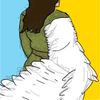HOME | DD
 Swanbrother — Illuminated Map Page
Swanbrother — Illuminated Map Page

Published: 2021-01-06 16:26:35 +0000 UTC; Views: 760; Favourites: 18; Downloads: 1
Redirect to original
Description
I had fun with this one because I let it be a map in-universe, complete with distortions and an agenda on the part of the in-universe artist. It is of course not at all distorted to put this important location dead center of a given landmass.
Priama, the center of the world, long may you keep peace in the serene valley.
God bless and keep these hills and rivers
------
“One leaf of the manuscript shows a map of the Midland Sea, with Priama centered in gold leaf. The text circling the map, in archaic Sarain, reads “Priama, the center of the world, long may you keep peace in the serene valley.” The lower text around the depiction of the city itself reads, in vernacular, “God bless and keep these hills and rivers.” The gilding around Priama is styled after a wind rose, with its hexadecagonal array and red and green “rhumb lines," but this is not a portolan chart, nor would it be especially useful for navigation of any kind, due to a number of distortions introduced to keep Priama at the forefront of the piece.
It’s a map with a message, and that message could not be clearer: Priama is still the center of the world.
The map is oddly orientated. East is at the top, as was usual in this period, but North is then situated to the right rather than the left as one would expect— by usual practice, the maps backward. This may have been done to center the upper-left santocerch[1] on the rough location The Holy Kingdom to the southeast, just off the edge of the map, or to place it symbolically above the sultanate which then held the pictured coast.
The greatest distortion lies on the western edge, toward the bottom of the map. The archipelago of Lithosiki as well as both the Agnian and Kystic Seas are subtly compressed. The effect of this is that while the physical location of Shehir[2] is visible, the bleeding edge of the empire that conquered it is still pushed to the furthest western edge— much further away from Priama than was geographically correct, thus much less of a threat than it truly was at this time.
——
[1] Literally “holy circle,” the symbol of the Church of Priama and its associated faiths. Represents the completeness and eternal, unending nature of God. It may also be representative of the circular “halo” distortions often reported by those who have had contact with outer beings, once widely thought to be visiting angels.
[2] In Priama, Shehir would still have been known by its former name, Grataniapoli.

















